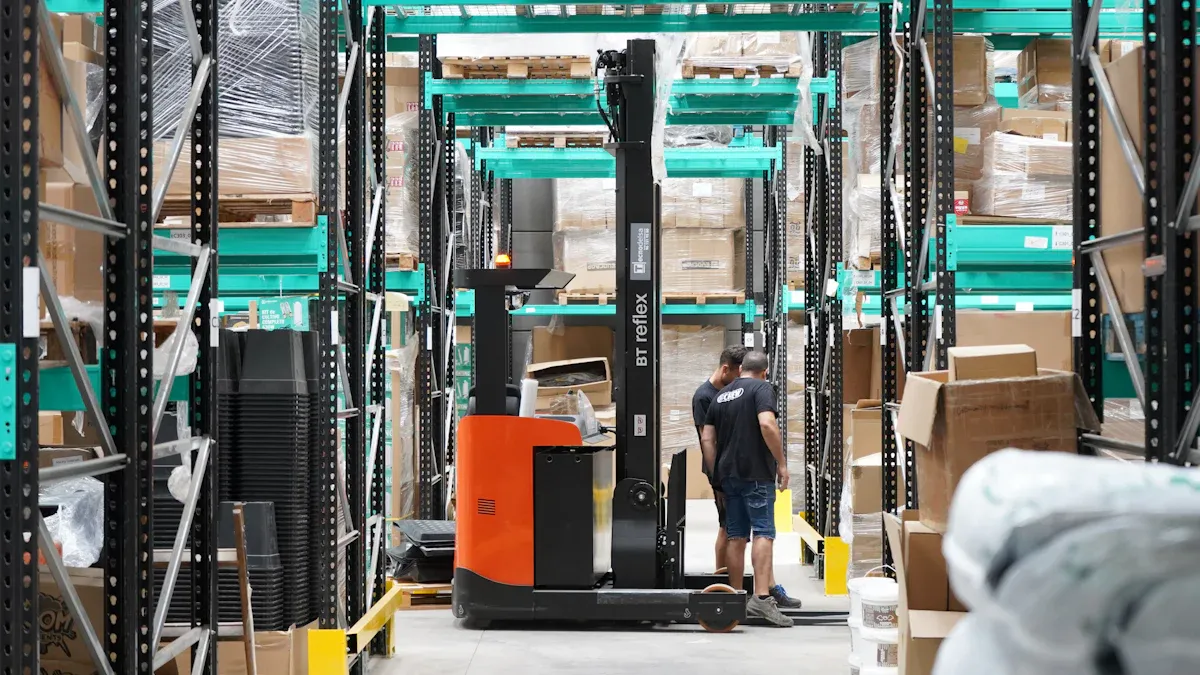7 Proven Ways to Optimize Reverse Logistics and Save Money

Reverse logistics plays a pivotal role in modern supply chains by managing the flow of returned goods efficiently. Its importance lies in reducing costs, improving customer satisfaction, and enhancing sustainability. Streamlining reverse logistics processes directly impacts supply chain efficiency by minimizing inventory losses, labor expenses, and transportation costs. Faster processing and better decision-making lead to improved profitability and brand sentiment. Businesses that adopt cost-saving strategies, such as leveraging technology and fostering partnerships, can achieve greater operational efficiency while supporting environmental goals.
The importance of reverse logistics extends beyond cost reduction, offering opportunities for waste reduction and better customer retention.
Streamline Returns Management for Cost Savings

Simplify Return Policies
Provide clear and concise return instructions.
Clear and concise return instructions form the foundation of an effective returns management process. Businesses often face challenges such as high costs and limited resale value of returned items due to unclear communication. Providing step-by-step guidelines ensures customers understand the process, reducing confusion and errors. For example, companies like EVEREVE and Invicta have implemented simplified policies that streamline the returns process, leading to significant cost savings and improved customer satisfaction. Clear instructions also minimize the time spent on customer support, allowing businesses to allocate resources more efficiently.
Minimize unnecessary steps in the return process.
Eliminating redundant steps in the returns process enhances efficiency and reduces costs. Simplified policies, such as restocking fees or local return bars, help manage customer expectations while promoting sustainability. For instance, Cuyana’s local return bars eliminate shipping waste, creating opportunities for cost savings and environmental benefits. By focusing on essential steps, businesses can process returns faster, reintegrate products into inventory, and improve the overall impact of reverse logistics strategies.
Automate Returns Management
Leverage tools like JUSDA's JusLink Intelligent Supply Chain for efficiency.
Automation transforms the returns management process by reducing manual errors and processing delays. Tools like JUSDA's JusLink Intelligent Supply Chain provide real-time tracking and automated decision-making, ensuring a seamless experience for both businesses and customers. Automation also enhances operational efficiency by streamlining the Returns Merchandise Authorization (RMA) process and optimizing the handling of product returns. Companies leveraging such technologies experience faster processing times and reduced costs, making automation a cornerstone of efficient reverse logistics.
Reduce manual errors and processing delays.
Manual errors in returns management often lead to increased costs and customer dissatisfaction. Automating key aspects of the returns process ensures consistent application of policies and minimizes mistakes. Businesses benefit from faster returns processing, improved inventory management, and enhanced customer loyalty. For example, automated systems provide timely updates to customers, fostering trust and encouraging repeat business. By reducing delays, companies can reintegrate returned items into stock more quickly, maximizing their resale value and achieving cost-saving strategies.
Tip: Automating the returns process not only reduces costs but also creates opportunities to improve customer satisfaction and loyalty.
Leverage Data Analytics to Optimize Reverse Logistics
Analyze Returns Data
Identify patterns and root causes of returns.
Data analytics plays a crucial role in identifying patterns and understanding the root causes of returns. Businesses can uncover trends such as common reasons for returns, peak return periods, or specific product categories with high return rates. For instance, predictive analytics can forecast future return volumes by analyzing historical data, enabling companies to prepare for seasonal spikes. Customer segmentation further refines this process by categorizing customers based on return behavior, allowing businesses to tailor their return policies effectively. These insights empower companies to address recurring issues, improving the efficiency of their reverse logistics strategies.
Use insights to improve product quality and reduce return rates.
Analyzing returns data provides opportunities to enhance product quality and reduce return rates. By understanding why returns occur, businesses can proactively address quality concerns. For example, identifying frequent issues like sizing problems or defects can guide product improvements. Additionally, adjustments to product descriptions and marketing strategies can help set accurate customer expectations, minimizing unnecessary returns and exchanges. Detailed analysis of return data also supports better decision-making, ensuring that reverse logistics processes remain effective and cost-efficient.
Optimize Inventory Management
Determine the best use for returned items (resale, refurbishment, recycling).
Effective reverse logistics requires optimizing the handling of returned items. Businesses must evaluate whether items should be resold, refurbished, or recycled. Automating the returns process ensures faster reintegration of products into inventory, improving inventory flow. Restocking returned products promptly reduces storage costs and maximizes resale opportunities. Companies can also collaborate with suppliers to refine product designs, minimizing future returns. This approach not only reduces costs but also supports sustainability goals by minimizing waste.
Minimize storage costs with JUSDA's Cloud Warehousing solutions.
Storing returned items that cannot be resold consumes valuable warehouse space, increasing costs. JUSDA's Cloud Warehousing solutions offer a cost-saving strategy by optimizing storage and inventory management. These solutions provide real-time visibility into inventory levels, enabling businesses to allocate space efficiently. By leveraging advanced technologies, companies can reduce storage costs and improve operational efficiency. JUSDA's expertise in returns management ensures that businesses can handle product returns effectively while minimizing their financial impact.
Tip: Businesses can use data analytics to forecast inventory needs, optimize warehouse space, and negotiate better terms with suppliers, further enhancing the efficiency of their reverse logistics processes.
Implement Reverse Logistics Technology
Use Real-Time Tracking Systems
Adopt RFID or barcode systems for enhanced visibility.
Real-time tracking systems have revolutionized reverse logistics by providing unparalleled visibility into the movement of returned products. Technologies like RFID and barcode systems allow businesses to monitor the status of returns in real time, addressing the common challenge of limited visibility. These systems enhance operational efficiency by reducing delays and optimizing delivery processes. For instance, RFID tags can track returned items from the moment they leave the customer’s hands until they reach the warehouse, ensuring accurate inventory updates. Additionally, GPS tracking complements these systems by offering precise location data, which improves transparency and customer satisfaction.
Note: Real-time tracking systems also leverage AI and machine learning to analyze delivery data, predict optimal routes, and manage potential delays. These advancements create opportunities for businesses to streamline their reverse logistics strategies and reduce costs.
Improve supply chain transparency with JUSDA's JusLink platform.
JUSDA's JusLink platform takes real-time tracking to the next level by integrating IoT and cloud computing. This platform provides end-to-end visibility across the supply chain, enabling businesses to monitor returns and exchanges with precision. JusLink enhances transparency by offering real-time updates on the status of returned items, which builds trust with customers and partners. Its predictive analytics capabilities also help businesses identify patterns in returns, allowing them to refine their reverse logistics strategies. By adopting JusLink, companies can achieve efficient reverse logistics while minimizing the impact of delays and errors.
Invest in Returns Management Software
Centralize return data for better decision-making.
Returns management software plays a critical role in effective reverse logistics by centralizing data and improving decision-making. These systems provide businesses with a comprehensive view of their returns, enabling them to predict future trends and manage inventory more effectively. For example, centralized data allows companies to identify high-return products and address quality issues proactively. This approach not only reduces costs but also enhances efficiency by ensuring that returned items are processed and reintegrated into inventory quickly. Businesses that invest in such software gain a competitive edge by optimizing their reverse logistics processes.
Automate communication with customers and partners.
Automation in returns management software simplifies communication, ensuring that customers and partners stay informed throughout the returns process. Automated notifications provide real-time updates on return status, fostering transparency and trust. These systems also streamline collaboration with logistics providers, reducing delays and improving the overall impact of reverse logistics operations. By automating key aspects of returns handling, businesses can reduce costs, increase efficiency, and reintegrate products into stock faster. This creates a seamless experience for all stakeholders, enhancing customer satisfaction and loyalty.
Tip: Combining automation with predictive analytics helps businesses identify opportunities to improve product quality and reduce return rates, further supporting cost-saving strategies.
Partner with Experts in Reverse Logistics
Collaborate with Third-Party Logistics Providers (3PLs)
Leverage JUSDA's expertise in cost-effective reverse logistics solutions.
Partnering with third-party logistics providers (3PLs) offers businesses access to specialized expertise and resources, enhancing the efficiency of reverse logistics processes. JUSDA, with its extensive global network and innovative solutions, provides tailored services that optimize returns and exchanges. By outsourcing to a 3PL like JUSDA, companies can reduce operational costs and improve the overall impact of their reverse logistics strategies.
Over two-thirds of businesses using 3PLs report significant cost savings.
Outsourcing logistics operations eliminates the need for in-house facilities, staff, and technology, converting fixed costs into variable expenses.
Efficient reverse logistics solutions enable faster returns processing, increasing customer satisfaction and creating opportunities for repeat purchases.
JUSDA’s expertise ensures effective reverse logistics by streamlining the entire process, from product recovery to resale or recycling. This allows businesses to focus on their core activities, such as product development and customer engagement, while leaving the complexities of reverse logistics to the experts.
Focus internal resources on core business activities.
Outsourcing reverse logistics to a 3PL frees up internal resources, enabling businesses to concentrate on strategic growth initiatives. Managing reverse logistics in-house often requires significant investment in infrastructure, technology, and personnel. By collaborating with a provider like JUSDA, companies can redirect these resources toward innovation and market expansion.
Additionally, 3PLs bring advanced technologies and industry insights that improve the efficiency of returns management. For example, JUSDA’s JusLink platform integrates IoT and cloud computing to provide real-time tracking and data-driven decision-making. This not only reduces costs but also enhances operational transparency, ensuring a seamless experience for customers and partners.
Negotiate Strategic Contracts
Align contracts with reverse logistics goals.
Effective contract negotiation is critical for aligning 3PL services with a company’s reverse logistics goals. Clear communication during the request for proposal (RFP) process ensures that all parties understand their roles and responsibilities. Businesses should define specific criteria and objectives upfront to prevent misunderstandings later.
Key considerations when negotiating contracts include:
Matching provider capabilities with the company’s reverse logistics needs.
Establishing performance metrics to measure success.
Setting expectations for cost-saving strategies and service quality.
JUSDA’s collaborative approach to contract negotiation helps businesses achieve their reverse logistics objectives while maintaining cost efficiency. Aligning contracts with these goals ensures a productive partnership that supports long-term success.
Monitor performance to ensure cost savings.
Regular performance monitoring is essential to ensure that 3PL partnerships deliver the expected cost savings and operational benefits. Businesses should track key performance indicators (KPIs) such as return processing times, inventory recovery rates, and customer satisfaction levels.
JUSDA’s advanced analytics tools provide real-time insights into reverse logistics operations, enabling businesses to identify areas for improvement. By continuously evaluating performance, companies can refine their reverse logistics strategies and maximize the value of their 3PL partnerships. This proactive approach ensures that the collaboration remains aligned with business objectives, driving both efficiency and profitability.
Tip: Establishing a feedback loop with 3PL providers helps address challenges promptly and fosters a culture of continuous improvement.
Optimizing reverse logistics involves implementing seven key strategies that drive efficiency and cost savings:
Automate processes to minimize errors and delays.
Centralize returns for streamlined operations.
Regularly evaluate transportation methods for improvements.
Leverage data analytics for informed decision-making.
Collaborate with third-party logistics providers for enhanced infrastructure.
Focus on sustainability through refurbishment and resale.
Design customer-centric return policies to improve satisfaction.
Technology, partnerships, and sustainability remain pivotal in achieving these goals. Tools like JUSDA's JusLink and Cloud Warehousing solutions empower businesses to enhance transparency, reduce costs, and meet environmental objectives. By adopting these strategies, companies can maximize ROI while fostering customer loyalty and operational excellence.
See Also
Mastering Logistics Cost Reduction: Your Comprehensive Handbook
Unlocking Savings in Logistics: Expert Tips for Efficiency
Five Creative Strategies for Optimizing Your Supply Chain
Are You Spending Too Much? Find Savings in Supply Chain
Understanding Supply Chain Costs: Strategies for Optimization
